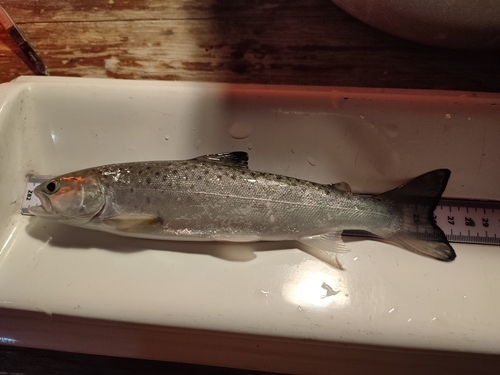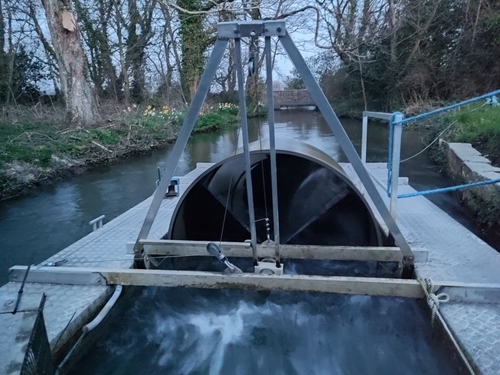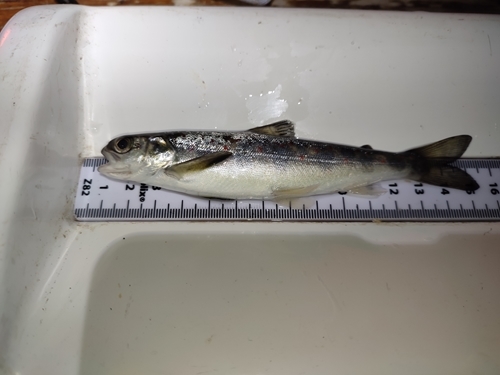
First trout smolt caught in 2022
The 25th March marked the start of the smolt trapping on the River Frome!
This is one of the busiest times of the year for the GWCT Fisheries Team.
At the start of the smolt run, the majority of the smolts are migrating at night. So, the Fisheries Team work around the clock in shifts to make sure that the trout and salmon smolts spend the shortest amount of time in the smolt trap before scanning them for the presence of a PIT-tag (a microchip with a unique code enabling us to identify individuals).
After scanning the fish for a PIT-tag we record biometrics, such as length and weight. Then they are released below the trap to continue their downstream migration to the sea.
A scale sample is collected from a strategic subset of the captured smolts. These scales can be used to age the smolts and to determine the sex of a fish, in order to establish the proportion of male to female fish in the population at this life stage. Sex is determined using genetics and this work has recently been funded by the EU SAMARCH project.
Prior to 2016 the smolt trapping operation started on the 1st April as this is when the salmon smolt start their migration. However, with the inclusion of juvenile trout in our PIT-tagging programme in 2015 we moved the start date of smolt sampling forward by a week in 2016. We did this as our trout smolt start their migration a few weeks earlier than the salmon smolts, and moving the start date forward enables us to sample a larger part of the trout migration window.

We use a rotary screw trap to catch a sample of the smolts as they are migrate to sea
Why do we operate a smolt trap on the River Frome?
Adult Atlantic salmon have been monitored on the River Frome since 1973. Creating one of the most comprehensive records of salmon movement and survival in England and Wales.
The River Frome is an Index River for Atlantic salmon, reporting on the marine return rate of wild salmon smolts (an indication of marine survival) to the International Council for the Exploration of the Seas (ICES). There are 12 index rivers spread around the Atlantic and the River Frome is the only index river operated and funded by a non-governmental organisation (NGO).
These rivers provide long term data on salmon population abundance and survival rates to ICES, to assess the status of Atlantic salmon stocks and provide scientific management advice to the North Atlantic Salmon Conservation Organisation (NASCO).
How do we obtain population estimates?
The Fisheries Team aims to capture 10,000 salmon and 3,000 trout parr in late summer every year, in order to insert a PIT-tag. PIT stands for Passive Integrated Transponder. As the fish migrate downstream on their journey to sea, and on their return as adults, the PIT-tags are detected by antennae positioned in the river operating 365 days a year. Each PIT-tag has a unique code which is recorded along with a time stamp by the antennae enabling us link these detections to the information on species, size, age and location recoded during tagging.
But only fish with a PIT-tag are detected and recorded, and it is impossible for us to tag every fish in the river!
So, catching fish in the trap and establishing the number of fish with a PIT-tag compared with the number of fish without a PIT-tag, enables us to extrapolate from detections of PIT-tagged smolts and determine the total size of the population.

First salmon smolt caught in 2022
How do we use the information we gather from our smolt surveys?
As a fisheries research group we are particularly interested in what the information from individual salmon and trout can tell us about the River Frome population, including survival, growth, timing of migration and response to environmental factors including habitat and the effects of climate change on fish populations.
We focus on sharing that information through the publication of scientific papers and the GWCT Fisheries Research Review, so that our research can help fisheries managers around the British Isles and further afield understand their fish populations enabling better management.
Would you like to know more about what we do?
To find out about the research conducted by the Fisheries Team please have a look at the annual Fisheries Research Reports, available to download here.
Published scientific papers from the Fisheries Team can be found here.
Two recent papers which are underpinned by the smolt monitoring:
Biological and environmental influences on the migration phenology of Atlantic salmon Salmo salarsmolts in a chalk stream in southern England
Simmons, O.M., Gregory, S.D., Gillingham, P.K., Riley, W.D., Scott, L.J., & Britton, J.R.
2021. Freshwater Biology, 66(8): 1581-1594.
Atlantic salmon return rate increases with smolt length
Gregory, S.D., Ibbotson, A.T., Riley, W.D., Nevoux, M., Lauridsen, R.B., Russell, I.C., Britton, J.R., Gillingham, P.K., Simmons, O.M., & Rivot, E.
2019. ICES Journal of Marine Science, 76: 1702-1712